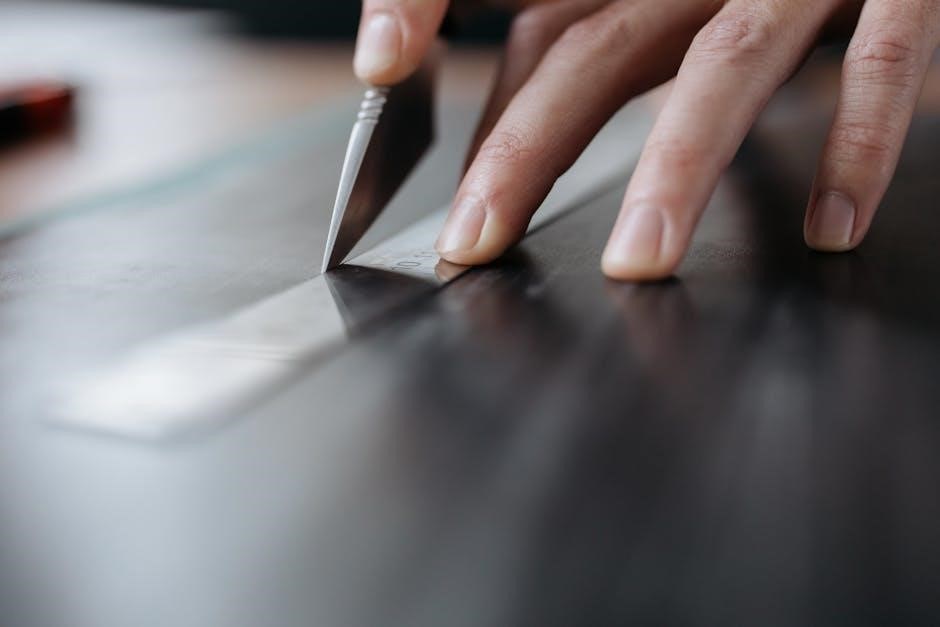A proper wheelchair fit is essential for comfort, mobility, and health. This guide provides step-by-step instructions to ensure accurate measurements, avoiding discomfort or limited mobility issues.
1.1 Importance of Proper Wheelchair Fit
A proper wheelchair fit is crucial for ensuring comfort, mobility, and overall health. Ill-fitting wheelchairs can lead to discomfort, poor posture, and even long-term health issues like pressure sores or joint pain. A well-fitted chair promotes independence, allowing users to navigate their environment safely and efficiently. It also supports physical alignment, reducing the risk of musculoskeletal problems. Proper fit enhances confidence and quality of life, enabling users to engage fully in daily activities. Measurements must account for individual needs, lifestyle, and physical characteristics to ensure the wheelchair is both functional and comfortable. Accuracy is key to maximizing mobility and well-being.
1.2 Overview of Key Measurements
Key measurements for a wheelchair include seat width, depth, and height, ensuring proper support and comfort. Seat width measures the hip-to-hip distance, while seat depth is from the back of the pelvis to the back of the knee. Seat height ensures feet can rest flat on the floor or footrest. Additional measurements like backrest height and armrest length are crucial for posture and accessibility. These dimensions ensure the wheelchair aligns with the user’s body, providing optimal support and mobility. Proper measurements enhance comfort, prevent health issues, and allow for easy navigation in various environments. Accuracy in these measurements is vital for a perfect fit.

Tools and Equipment Needed for Measuring

A retractable metal tape measure, large callipers, and a clipboard or book are essential tools for accurate wheelchair measurements, ensuring precision and proper fit.
2.1 Retractable Metal Tape Measure
The retractable metal tape measure is a versatile tool for obtaining accurate body and wheelchair dimensions. It allows for easy measurement of seat width, depth, and height. Its flexibility enables users to wrap it around contours, such as the hips or knees, ensuring precise readings. When measuring, ensure the tape is taut but not stretched, as this could lead to inaccuracies. Always record measurements in a consistent unit, such as centimeters or inches, to avoid confusion. Proper use of the tape measure is crucial for a well-fitting wheelchair, enhancing comfort and mobility for the user.
2.2 Large Callipers for Accurate Dimensions

Large callipers are essential for obtaining precise measurements, particularly for the seat width and depth. They provide accurate readings by firmly gripping the outer edges of the body or wheelchair. Unlike tape measures, callipers can measure wider spans with greater reliability, ensuring proper fit and comfort. When measuring the hips or knees, position the callipers perpendicular to the body to avoid skewed results. This tool is especially useful for individuals with limited mobility, as it allows for precise adjustments without discomfort. Using callipers helps prevent errors like a seat that’s too narrow or too wide, which can lead to discomfort or restricted movement. Always record measurements carefully to ensure accuracy.
2.3 Clipboard or Book for Support

A clipboard or sturdy book provides essential support during measurements, ensuring accuracy and comfort. Place it behind the individual to maintain proper posture, especially when measuring the backrest height or seat depth. This tool helps prevent slouching and ensures the measurements reflect the user’s natural alignment. The clipboard also serves as a stable surface for recording measurements immediately, reducing the risk of errors. For wheelchair users, this support can be placed at the back of the pelvis to gauge the ideal backrest position. Using a clipboard or book simplifies the process, making it easier to achieve precise and reliable results for a perfect wheelchair fit.
Key Wheelchair Measurements
Accurate measurements are crucial for comfort and mobility. Key dimensions include seat width, depth, and height, as well as backrest height and armrest placement to ensure a perfect fit.
3.1 Seat Width Measurement
Seat width is measured across the widest part of the hips or thighs while seated. Add 2-3 inches for comfort and movement. Use a metal tape measure or callipers for accuracy. Ensure the user is in a neutral posture with feet flat or supported. This ensures the wheelchair is neither too tight nor too loose, promoting proper posture and preventing pressure sores. Record the measurement and compare it with the wheelchair’s specifications to find the best fit. Accurate seat width ensures optimal comfort and ease of use, making it a critical measurement in the fitting process.
3.2 Seat Depth Measurement
Seat depth measures the distance from the back of the pelvis to the back of the knee while seated. Use a metal tape measure for accuracy. The user should sit with feet flat on the floor or supported, maintaining a 90-degree knee angle. Ensure the measurement does not compress soft tissues. The seat depth should allow 2-3 inches of clearance between the back of the knee and the edge of the seat for comfort and to prevent pressure sores. Proper seat depth ensures proper posture and prevents the legs from being too far forward or backward, which can lead to discomfort or restricted circulation. Accuracy is key for optimal fit and health.
3.3 Seat Height Measurement
Seat height measures the distance from the floor to the seat surface, ensuring proper foot placement and mobility. The user should sit with feet flat on the floor or on a footrest, maintaining a 90-degree knee angle. Use a metal tape measure for accuracy, placing it vertically from the floor to the seat. Add 1/2 inch for shoe thickness and cushion compression, if applicable. Proper seat height allows the user to propel the wheelchair effectively and prevents issues like poor posture or limited mobility. Accurate measurement is crucial for comfort, functionality, and overall wheelchair performance.
Additional Considerations for Fit
Proper fit ensures optimal comfort, mobility, and health. Consider posture support, pressure distribution, and adjustability for various activities, ensuring the wheelchair meets individual needs and preferences effectively.
4.1 Backrest Height and Angle
Proper backrest height and angle are crucial for posture, comfort, and upper body support. Measure from the pelvis to the back of the knee to determine optimal height. The backrest should align with the natural curve of the spine, providing adequate lumbar support. The angle should allow the user to sit upright without pressure on the shoulders. Ensure the backrest does not push the head forward, as this can cause discomfort. Adjustments may be needed for different activities or postures. Consider adding 2 cm for clothing like jackets. Proper alignment ensures reduced strain and promotes long-term comfort and mobility.
4.2 Armrest Height and Length
Armrest height and length are crucial for comfort and functionality. Measure the armrest height from the seat to the top of the armrest, ensuring it allows the arms to rest at a 90-degree angle. The length should be measured from the shoulder to the wrist to ensure proper support. Consider adding 2 cm for clothing thickness. Ensure armrests are neither too long nor too short to avoid interference with leg movement or inadequate support. For both manual and power wheelchairs, these measurements ensure optimal comfort and prevent strain. Use a retractable metal tape measure for accuracy and adjustability to meet individual needs.

How to Measure for a Wheelchair
Measure seat width, depth, and height using a retractable metal tape measure. Ensure the person is seated comfortably, feet flat, and consider posture and clothing thickness for accuracy.
5.1 Step-by-Step Measuring Process
Begin by ensuring the individual is seated comfortably with feet flat on the floor or a firm surface. Measure seat width by determining the widest distance across the hips or shoulders, adding 2 cm for comfort. For seat depth, measure from the back of the pelvis to the back of the knee, ensuring the user can sit without pressure. Seat height is measured from the floor to the underside of the thigh, allowing a 2-inch clearance. Use a retractable metal tape measure or callipers for accuracy. Record all measurements on a clipboard or form to ensure consistency and avoid errors during fitting.
Tips for Accurate Measurements
Account for clothing and posture variations. Use measurement forms for consistency. Ensure the individual is in their desired seated position for reliable results.
6.1 Accounting for Clothing and Posture
When measuring, consider the type of clothing the user typically wears, as thick fabrics can affect seat and backrest measurements. Posture plays a crucial role; ensure the individual sits naturally. Use a firm surface and support their feet to maintain proper alignment. Adjustments may be needed for slouching or uneven sitting. Soft tissues should not be compressed during measurements. Adding 2 cm to certain dimensions can accommodate winter clothing. These considerations ensure the wheelchair fits comfortably and supports the user’s needs effectively, promoting long-term comfort and mobility, while also preventing potential health issues related to poor posture or tight clothing.

6.2 Using Measurement Forms for Consistency
Using measurement forms ensures accuracy and consistency when recording dimensions. They help track key measurements, such as seat width, depth, and height, preventing errors. Forms also prompt you to account for clothing and posture, ensuring adjustments are made for comfort and support. By documenting every measurement, you can compare and verify data, reducing the risk of mistakes. Measurement forms also provide a clear record for future reference or adjustments. This organized approach guarantees a well-fitted wheelchair, tailored to the user’s needs, and minimizes the likelihood of discomfort or mobility issues. Consistency is key to achieving the perfect fit, every time.

Common Mistakes to Avoid
One of the most common mistakes is not accounting for clothing or posture during measurements, leading to an ill-fitting wheelchair. Overlooking the importance of proper tools, such as a metal tape measure or callipers, can result in inaccurate dimensions. Additionally, failing to add clearance for floor space or not considering the user’s sitting position can cause discomfort or limited mobility. Another mistake is not documenting measurements consistently, which can lead to confusion or errors. Avoid rushing the process, as precise measurements are crucial for optimal fit and functionality. By being mindful of these pitfalls, you can ensure a wheelchair that meets the user’s needs effectively.




